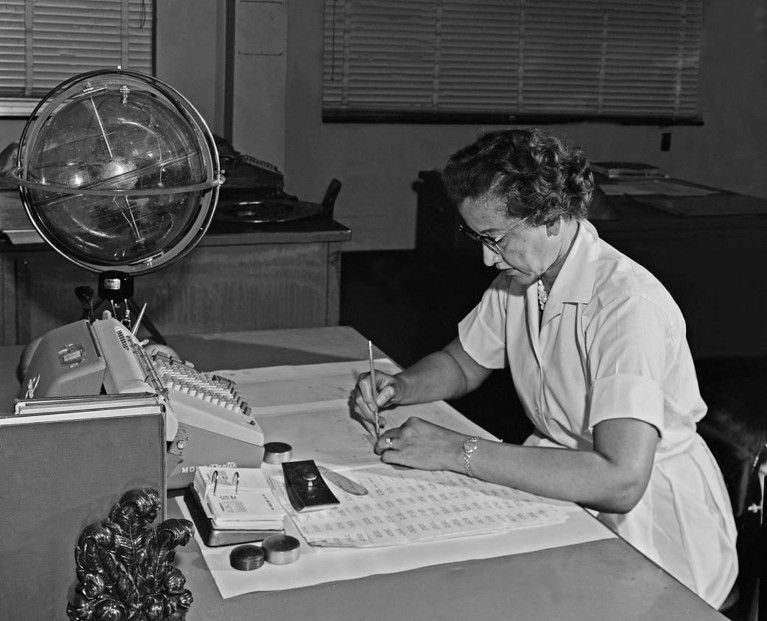Katherine Johnson was the most recognized of the African American “human computers” — female mathematicians who worked at NASA and its predecessor, the National Advisory Committee for Aeronautics (NACA), from the 1930s until the 1980s. Johnson was most proud of the calculations that she contributed to the Apollo 11 mission to place the first human on the Moon. But it was her role producing and checking the trajectory equations for astronaut John Glenn’s pioneering Project Mercury orbital space flight in 1962 that established her professional reputation.
Wider fame for Johnson came in 2016 with the publication of my group biography Hidden Figures, and the release of the film based on it. Asked about the challenges of being black in a segregated workplace, or of having upended the no-women policy in her division’s research meetings, she was most likely to reply: “I was just doing my job.”
A gifted mathematician who always followed her curiosity, Johnson became a powerful symbol of the often-unheralded contributions that women and minority ethnic groups have made to science, technology, mathematics and computing over the course of the twentieth century. Although her fascination with numbers was obvious from childhood — she recalled counting dishes, stars, steps, everything — the possibility of deploying her talent as a professional mathematician was anything but.
Born Katherine Coleman in White Sulphur Springs, West Virginia, she and her three siblings were sent 200 kilometres away by their parents to be educated, because there was no local school beyond sixth grade for those who were called ‘coloured’ students in the pre-civil-rights-era United States. Teachers allowed her to skip several grades in school, and she was just 14 when she entered the historically black West Virginia State College in Institute to study mathematics. There, she became the top student of acclaimed topologist William Waldron Schieffelin Claytor, the third African American to earn a PhD in maths. Neither pupil nor teacher knew where, or even if, she would be able to put this rigorous training to work; prior to the Second World War, women with mathematics degrees were most often required to go into classroom teaching.
Johnson graduated in 1937 and, predictably, spent two years teaching in West Virginia’s segregated public schools. In 1939, she was hand-picked by the president of West Virginia State College to be one of the first black students to be allowed to study in the graduate programme in West Virginia University, Morgantown. After one semester, however, she left to get married, and spent the next 13 years raising a family and teaching in public schools in neighbouring Virginia.
In 1952 she applied to work at NACA’s research outpost in Hampton, Virginia, then called the Langley Aeronautical Laboratory. She began her career in the all-black, all-female West Area Computing Unit, helmed by mathematician Dorothy Vaughan. Vaughan soon sent her to fill an opening in the Flight Research Division, a group that specialized in tests on actual aeroplanes, rather than wind-tunnel simulations. For five years, Johnson was part of an engineering team that investigated phenomena such as wake turbulence, leading to improved safety for military and commercial aviation.
The Soviet Union’s launch of the Sputnik satellite in 1957 ignited the space race and spurred the transformation of NACA into the space agency. The Flight Research Division diverted its attention to spacecraft, and by 1958, Johnson had contributed to ‘Notes on Space Technology’, the agency’s first comprehensive reference document on space flight. By 1959, she had prepared a trajectory analysis for a crewed suborbital flight. The following year, she co-authored the research report ‘Determination of Azimuth Angle at Burnout for Placing a Satellite Over a Selected Earth Position’, laying out the equations that would form the basis of that crewed orbital space flight piloted by Glenn.
Her named credit on the report was a first for a woman in her division, and positioned her to play a part in a mission that enabled the United States to draw even with the Soviet Union — one of the pivotal moments of the space race. In the days leading up to Glenn’s flight, the astronaut asked Johnson — “the girl”, as he called her — to hand-check the trajectory equations that had been input into the IBM 7090 computer. The flight forever linked a black female mathematician to one of the United States’ most glorious achievements. Johnson later contributed calculations to the parking orbit of Apollo 11’s command and service module during the first crewed Moon landing. She spent the latter years of her career working on the Space Shuttle.
Charismatic and gregarious, Johnson embraced her work and her colleagues with the same enthusiasm. Lunch usually found her at her desk, playing a fiercely competitive game of bridge with engineers Al Hamer and John Young. She became best friends with Eunice Smith, another West Area Computing employee, and the two took a week off from work each year to attend a basketball tournament of historically black colleges.
After retiring from NASA in 1986, she regularly visited classrooms to enchant students with the wonders of mathematics and the benefits of pursuing a career in science, technology, engineering or mathematics. Even as the popularity of Hidden Figures turned her into something of a celebrity, Johnson, with characteristic understatement, sought to deflect the attention.


 Hidden Figures: the movie
Hidden Figures: the movie
 The Harvard computers
The Harvard computers
 John Glenn (1921–2016)
John Glenn (1921–2016)







